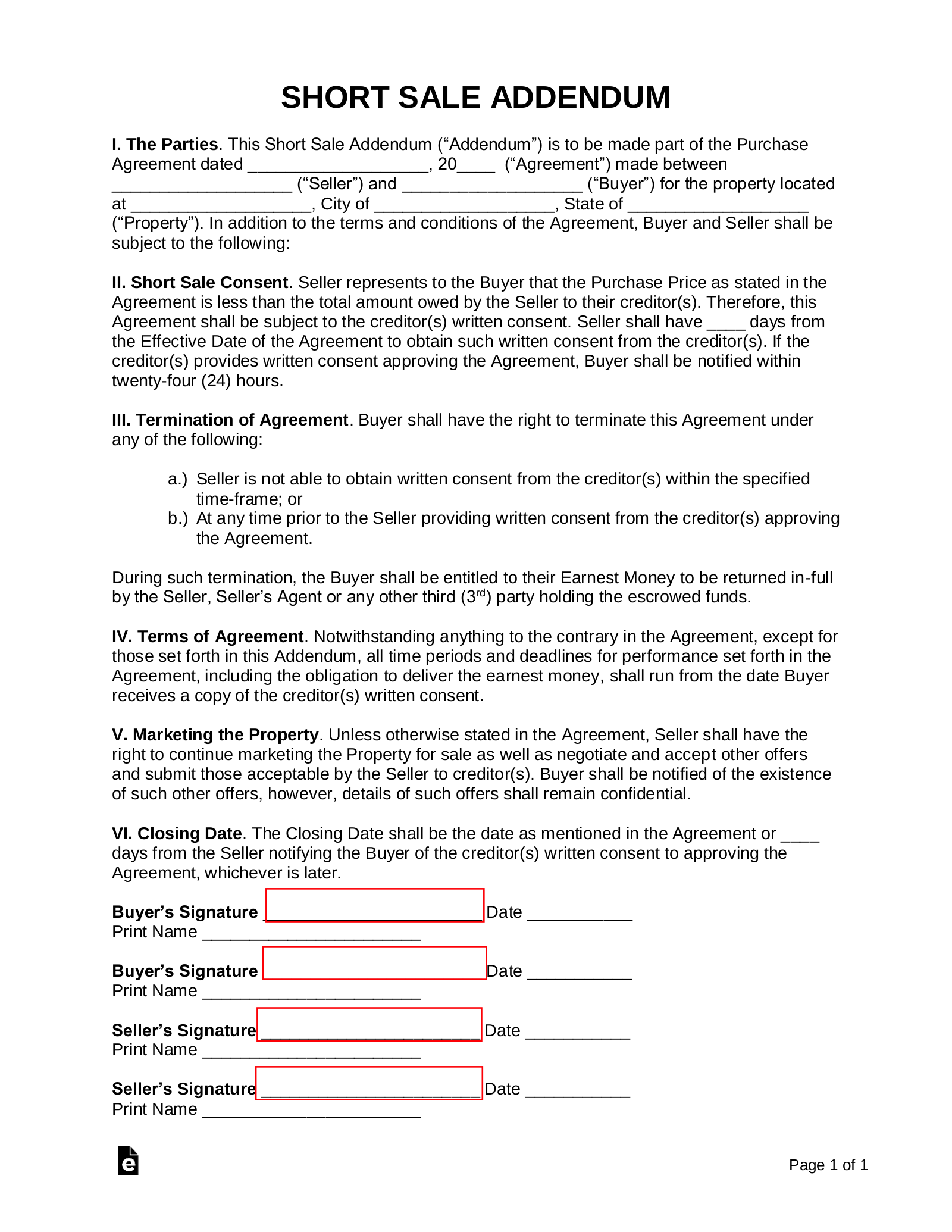Updated August 23, 2023
A short sale addendum is intended for a seller of real estate that owes more money on the property than it’s worth. Therefore, the seller is required to field offers from potential buyers and add this addendum to the purchase agreement which requires the seller to seek the creditor’s consent in order to sell the property.
The seller may still be obligated to pay the creditor the remaining balance after the closing. While the seller is seeking consent from the creditor, the buyer may opt out of the agreement. At the same time, the seller may field as many offers as possible while at the same time negotiating with the buyer.
Proving Hardship – In most cases, the seller will attempt to claim some type of financial hardship to the creditor in order to have the short sale approved. This may be due to a change in economic events, loss of job, medical reasons, etc.
Table of Contents |
By State
- Alabama
- Alaska
- Arizona
- Arkansas
- California
- Colorado
- Connecticut
- Delaware
- Florida
- Georgia
- Hawaii
- Idaho
- Illinois
- Indiana
- Iowa
- Kansas
- Kentucky
- Louisiana
- Maine
- Maryland
- Massachusetts
- Michigan
- Minnesota
- Mississippi
- Missouri
- Montana
- Nebraska
- Nevada
- New Hampshire
- New Jersey
- New Mexico
- New York
- North Carolina
- North Dakota
- Ohio
- Oklahoma
- Oregon
- Pennsylvania
- Rhode Island
- South Carolina
- South Dakota
- Tennessee
- Texas
- Utah
- Vermont
- Virginia
- Washington
- Washington, D.C.
- West Virginia
- Wisconsin
- Wyoming
By Bank
How Does a Short Sale Work? (6 steps)
- Get Sale Comparables in the Area
- Write a Financial Hardship Letter
- Gather Financial Statements
- Attach Other Documents
- Send Hardship Letter to the Bank
- Obtain the Bank’s Approval
1. Get Sale Comparables in the Area

If a home is no longer worth the amount of its mortgage value, chances are that the local market has also seen the prices depreciate. Have a local real estate agent gather homes that are similar or lesser in square footage and amenities to get an understanding of the current value of your home. In addition, if the agent can show a trajectory of where the market has been the last 6 or 12 months to give an idea that the bank should “jump ahead” of the market before losing even more money.
2. Write a Financial Hardship Letter

The bank knowing that homes in the area are selling for less money is not good enough to be qualified for a short sale. The mortgagor will need to prove that they have suffered a change in their financial situation, such as loss of employment, loss of income, too many financial liabilities, etc.
A bank stands to lose more money in the event of a foreclosure and it’s in their best interest to sell the property at a loss while the mortgagor is still making their payments.
3. Gather Financial Statements

In order to back up and give proof that the financial hardship letter is true and accurate, the following will be required:
- Two (2) years of tax returns (including W2’s and 1099’s);
- Last two (2) months of pay stubs and income;
- Last two (2) months of bank statements; and
- A list of all expenses and liabilities.
When the financial package is complete it should be attached to the letter.
4. Attach Other Documents

The seller of the home can choose to make this request at the time of signing a listing agreement or purchase agreement with a qualified buyer. In either case, the agreements will need to be attached.
If there is a real estate agent involved the seller will need to complete and sign, along with the real estate agent, the third (3rd) party authorization form. View the samples for the following financial institutions:
5. Send Hardship Letter to the Bank

Once the documents are sent to the bank, it will take from 10 to 45 days to review the documents. During this time, the seller should market their property in an effort to find the most qualified purchaser for the highest price.
Once a buyer has been found, the purchase agreement will be needed to be sent to the bank.
6. Obtain the Bank’s Approval

After the bank has been notified of the offer the bank will undergo its own approval and appraisal process that can take up to 120 days. This will involve the bank reviewing all documents, scheduling an appraisal, qualifying the buyer, assigning a negotiator, and finally approving or rejecting the terms of sale.
If a sale is approved, the financial obligations of the seller to the bank will be negotiated as a separate matter.
Short Sale vs. Foreclosure (auction)
| Short Sale | Foreclosure (auction) | |
| Balance after the home is sold | Zero ($0) | Sales price less mortgage balance |
| Seller current with mortgage payments? | Yes | No |
| Affects the Seller’s credit score? | No | Yes |
| When does the bank agree to the sales price? | When an offer is presented | After the foreclosure (auction) event |


